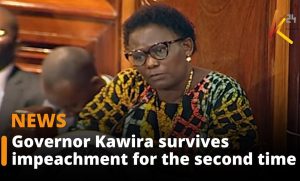ET reveals abuse of office at Kenya government’s new weekly
The newspaper project that was mooted to support the government’s rural development efforts is riddled with intrigue, nepotism and crafty schemes that have left Roy Gachuhi, a noted journalist and media trainer, with a bitter taste in the mouth. Gachuhi, whose gripping investigative series about the 1982 military coup attempt was recently run by Nation newspapers, is the proprietor of the East Africa School of Journalism in Nairobi.
Some time in August 2008, Gachuhi visited the office of Ezekiel Mutua, the Director of Information and Public Communications, at Jogoo House where he chanced on a copy of Mwangaza, one of 11 newspapers then published by the department under its Rural Press Section. Mwangaza served part of Rift Valley Province. The other papers were: Sauti ya Pwani for Coast Province, Nyota ya Mashariki for Eastern, Maarifa for Central, Nuru for Eastern, Ngao for Rift Valley (Nakuru), Sauti ya Kericho (Rift Valley), Sauti ya Gusii (Nyanza), Jicho (Siaya, Nyanza), Nyota ya Magharibi (Western) and Habari (North Eastern).
The 16-page newspapers were published in English or Kiswahili and sold at Sh20 per copy. But their circulation remained dismal. Of the 2,000 copies printed per title, only Sauti ya Kericho sold 90 percent, followed closely by Sauti ya Pwani and Jicho. Mutua was keen to improve the newspapers. “I asked him whether our school could be given the task of revamping the magazaines to make them commercially viable. He immediately agreed and asked me to produce dummies of the same,” Gachuhi recalls.
He went ahead and produced two dummies of the proposed newspaper. “Mr. Mutua was so pleased with them that he immediately sought and obtained an appointment with [the Permanent Secretary, Ministry of Information and Communications] Bitange Ndemo to introduce us and to set the contractual process between the East Africa School of Journalism and the Department of Information in motion.”
Dr Ndemo was equally pleased with the idea and the dummies. He asked for a draft Memorandum of Understanding to be forwarded to the Attorney General’s office for approval. “At this stage, it was quite clear to us that the Department had contracted us,” Gachuhi says.” He and his team embarked on drafting the MOU which they thereafter forwarded to Mutua’s office for onward transmission to the AG. At the same time, Gachuhi set about hiring staff and allocating space at EASJ for the project.
According to the draft MOU of November 2008, the EASJ and the Government of Kenya (represented by the Department of Information) agreed to work together to redesign all the 11 newspapers to make them more attractive and readable to the rural population. The papers would be in full colour and would support rural development through lively, diversified, readable and interesting content. The MOU parties also undertook to seek advertising to promote the viability of the publications.
The MOU was anchored on the government’s Public Private Partnership initiative which is meant to improve service delivery while supporting private sector growth. The agreement was to run for 15 years. EASJ would handle all the editorial work, design, advertising and circulation of the papers while the Department of Information would provide editorial support and solicit advertising from government ministries and agencies. Any profits made from the project would be shared between the EASJ and the Department of Information on a 70/30 percent basis respectively.
On October 9, 2008, the Solicitor General at the State Law Office, Mr Wanjuki Muchemi, wrote to Dr Ndemo proposing several amendments to the MOU. Once the corrections had been done, Mutua wrote to Gachuhi on November 21, 2008, informing him that “the draft Memorandum of Understanding between yourselves and the Ministry regarding the above matter has been reviewed and approved by the Attorney General. We will revert to you shortly to inform you when the document is ready for our mutual signatures. Meanwhile, please arrange to avail to us dummy copies of the Rural Press publications covering the 11 stations.”
An excited Gachuhi wrote back immediately asking for Sh15, 000 for the dummies.
But the pace of things slackened, perhaps because of the onset of the Christmas/New Year season. Still, Gachuhi wrote to the government indicating that EASJ was running up losses because of the delay in executing the contract. “On completion of the above MOU to the satisfaction of the Attorney General, we appended our signature on the document and forwarded it to you for the same in readiness for implementation of the project,” Gachuhi said in a letter to PS Ndemo on February 13, 2009.
“We proceeded to set aside space in our offices for the project and put a number of staff – and some external consultants – on notice for project commencement. That was in November, 2008. We have not heard from your side and this has resulted in a state of costly operational paralysis for us regarding the space set aside and the decision whether or not to release personnel earmarked for the project.” The letter pushed the government into action. The MOU was signed on March 11. The project would be piloted for six months.
The Department of Information then organized a sensitization workshop between all its field officers (Provincial Information Officers, Bureau Chiefs, Editors and printers) and EASJ to brief the Ministry personnel about the new project. Mutua wrote to his officers on March 26, inviting them for the workshop which would “strategize on implementation of the MOU.” The one-day meeting would take place on April 8 at the Ministry of Information and Communication boardroom, Teleposta Towers, 9th Floor, starting 8.30 a.m.
“One of the resolutions that emerged from that workshop was that the Rural Press was to be re-branded and given one name,” Gachuhi recalls. “Instead of 11 newspapers carrying different titles, they should be given one title that would be marketed to be recognizable throughout the country. Various names were suggested but adoption of one name was deferred.”
On April 16, 2009, EASJ wrote to Mutua, submitting 10 names and asking him to select a suitable one. “We need this to design and present this new brand name on the dummies that we are currently working on. These dummies are part and parcel of the Roll-Out Plan.” The names proposed by EASJ were: The Patriot, The Nationalist, Mwangaza, Mwananchi, Kenya Today, The Kenyan, Mzalendo, The Flag, The New Age and The National Agenda.
Mutua wrote to EASJ four days later selecting the name Kenya Today. The two-paragraph letter reads: “Kenya Today would be more appropriate as it can very easily fit the regional editions structure. Besides, we are currently publishing the Inside Kenya Today which is circulated within the Ministries. I therefore propose that we adopt Kenya Today and fit in the regional editions accordingly, e.g. Western Kenya Today, Eastern Kenya Today etc.”
Having got the green light, EASJ designed a dummy copy of the new Kenya Today, but they could not submit it because the Director of Information was reportedly on an extended overseas trip. Nothing happened for a month. On May 26, Gachuhi wrote to PS Ndemo in an attempt to get things going. Nothing.
“We held on to our dummies from April until mid-June when a meeting finally took place between the school, the Director and the PS in the PS’s office. At the meeting the PS requested that we do an actual paper to resemble the dummy we had presented so that he could show it to the Head of the Public Service. We told him that we could but that he should foot the printing costs. He accepted to do that. But he never released any funds.”
The school went ahead and contracted writers, photographers and other staff and actually did the real Kenya Today newspaper as requested by the PS. But they did not print any copies because the PS had not released the money. “When this process took too long, the school suggested that if the Ministry was having problems raising funds, we could assist by getting advertisers to do it. We asked the Ministry to do letters to its various corporations and departments requesting them to advertise in the forthcoming paper.”
The Ministry quickly did that. Using the letters, EASJ collected adverts worth Ksh1.1 million. “We forwarded copies of all these bookings to the Director of Information,” says Gachuhi.
Strange twist
Then the project took a strange twist. “On August 16, 2009, the Director of Information called me and told me the Minister [Samuel Poghisio] had people in mind who could produce Kenya Today to a high standard. He asked me whether the school could work with those people. He said he was under pressure to make it happen. I said I could not, under any circumstances. He told me he understood and he would relay the information to the Minister,” says Gachuhi.
Apparently after talking to Minister Poghisio, Mutua wrote to Gachuhi on August 18: “This is to inform you that the Department of Information has with immediate effect suspended all arrangements previously entered into with your institute regarding the publishing of Kenya Today. This follows your failure to meet the first production deadline of August 1, 2009, which has put the department in a precarious position regarding its fulfillment of the Performance Contract targets on the said publication and set Appropriation in Aid (A in A) revenue.
“Please note that under the Performance Contract, the department is expected to produce 3,000 copies of the said publication every month and remit the revenue accruing from the same monthly. It is now over three months since your institution undertook to publish Kenya Today on behalf of the department and your failure to deliver means we have a backlog of 9,000 copies. In light of the above, the department has been forced to make alternative arrangements to meet its contractual obligations.
“Please note that the department will not accept any responsibility regarding any arrangements you may have entered with advertisers regarding Kenya Today. However, our existing MOU on the revamping of our Rural Press remains in force and is not in any way affected by this decision. You should, however, bear in mind that unless you fulfill your part of the MOU by 1st October, 2009, the department will have no choice but to also review the MOU accordingly. This letter supersedes any previous correspondence on this matter.”
The following week on August 24, Kenya Today hit the newsstands, exactly as EASJ had designed it and carrying the same advertisement the school had booked. Gacs the school is concerned, we were set up to conceive, develop and produce a project that some people in the Ministry had all along earmarked for other people. We never delayed anything. They did, as the flow of correspondence shows. The greatest loss to us is the diversion from other business for one year chasing a wild goose at somebody’s behest.” ***
Trade unionist
Gachuhi was at his wits’ end. How could a senior state official – a former journalist and high-minded trade unionist to boot – let this happen to a professional colleague and Kenyan pursuing an honest living? How could Mutua who says he reads the Bible and William Shakespeare “when I am in need of sources of spiritual and intellectual inspiration, when I am bone weary and stressed beyond endurance”, put another person through all that heart-breaking mess?
Gachuhi wanted to do everything in his power against this treachery. At least if the deal fell through, Mutua had the obligation to refund EASJ the costs of conceiving and designing Kenya Today. But he made little headway. The final nail on the MOU coffin was hammered in an ominous SMS sent to Gachuhi by Mutua on Saturday, October 24, 2009: “Roy, the route you have taken will only cause you pain and ruin our friendship for ever. I have nothing against you. If you want us to talk the door is open but remember our MOU is not on Kenya Today but Rural Press. Kenya Today is a different arrangement and is not part of the MOU.”
Gachuhi now says Kenya Today is “a paper founded on deceit.” He has in the past months scratched his head in search of the appropriate reaction. He considered suing for theft of intellectual property, seeking the services of an arbitrator or lodging a complaint with the Media Council of Kenya. But he has kept wondering if it would not all be a waste of more time, money and emotional energy.
“I have decided definitively not to pursue that case,” he told ET. And he looks back with sadness. “We are the ones who developed the concept of Kenya Today. At the end of it, it was taken away and now Kenya Today is on the street. We spent time and money. Now our designer watches as Kenya Today is sold on the street. If those people were decent, they would have said, ‘Fine, we are terminating this. Here, this is what is due to you’.”
In the December 21-27 issue of Kenya Today, Mutua, who is the paper’s Editorial Director, wrote a thank-you piece titled, ‘Special Tribute to Those Behind Our Success.’ He praised Ministries and departments and their heads and the KT staff. “We owe a huge debt of gratitude to all of you who contributed in one way or another in making what was a dream a three-dimensional reality.”
Not a mention of Roy Gachuhi and the East Africa School of Journalism, of course.





